Assessment |
Biopsychology |
Comparative |
Cognitive |
Developmental |
Language |
Individual differences |
Personality |
Philosophy |
Social |
Methods |
Statistics |
Clinical |
Educational |
Industrial |
Professional items |
World psychology |
Biological: Behavioural genetics · Evolutionary psychology · Neuroanatomy · Neurochemistry · Neuroendocrinology · Neuroscience · Psychoneuroimmunology · Physiological Psychology · Psychopharmacology (Index, Outline)
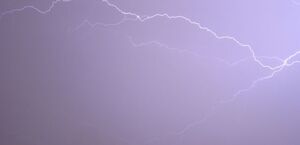
Lightning strikes during a night-time thunderstorm. Energy is radiated as light as the air of Earth's atmosphere is shifted from gas to plasma and back.
This is a hub page for electricity. You can find specific information by following the Main article links
Electricity is a property of matter that results from the presence or movement of electric charge. Together with magnetism, it constitutes the fundamental interaction known as electromagnetism. Electricity is responsible for many well-known physical phenomena such as lightning, electric fields and electric currents, and is put to use in industrial applications such as electronics and electric power.
Concepts in electricity[]
In casual usage, the term electricity is applied to several related concepts that are better identified by more precise terms.
- Electric charge: a fundamental conserved property of some subatomic particles, which determines their electromagnetic interactions. Electrically charged matter is influenced by, and produces, electromagnetic fields.
- Electric field is an effect produced by an electric charge that exerts a force on charged objects in its vicinity.
- Electric potential: the potential energy per unit charge associated with a static (time-invariant) electric field.
- Electric current: a movement or flow of electrically charged particles.
- Electrical energy: energy made available by the flow of electric charge through a conductor or from the forces between charged particles.
- Electric power: The rate at which electric energy is converted into another form, such as light, heat, or mechanical energy (or converted from another form into electric energy).
History[]
Ancient[]
According to Thales of Miletus, writing 600 BC, a form of electricity was known to the Ancient Greeks who found that rubbing fur on various substances, such as amber, would cause a particular attraction between the two. The Greeks noted that the amber buttons could attract light objects such as hair and that if they rubbed the amber for long enough they could even get a spark to jump.
An object found in Iraq in 1938, dated to about 250 BC and called the Baghdad Battery, resembles a galvanic cell and is believed by some to have been used for electroplating.
There has been speculation that an object shown in carved reliefs at the temple of Dendera was an electrical device - the so-called Dendera light - although there is no archaeological evidence to support this.
Modern[]
In 1600 the English scientist William Gilbert returned to the subject in De Magnete, and coined the modern Latin word electricus from ηλεκτρον (elektron), the Greek word for "amber", which soon gave rise to the English words electric and electricity. He was followed in 1660 by Otto von Guericke, who is regarded as having invented an early electrostatic generator. Other European pioneers were Robert Boyle, who in 1675 stated that electric attraction and repulsion can act across a vacuum; Stephen Gray, who in 1729 classified materials as conductors and insulators; and C. F. Du Fay, who first identified the two types of electricity that would later be called positive and negative.
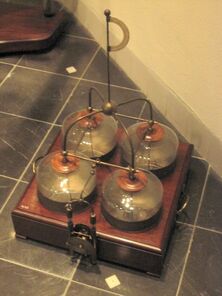
Leyden jars, Museum Boerhaave, Leiden [1].
The Leyden jar, a type of capacitor for electrical energy in large quantities, was invented at Leiden University by Pieter van Musschenbroek in 1745. William Watson, experimenting with the Leyden jar, discovered in 1747 that a discharge of static electricity was equivalent to an electric current.
In June, 1752, Benjamin Franklin promoted his investigations of electricity and theories through the famous, though extremely dangerous, experiment of flying a kite during a thunderstorm. Following these experiments he invented a lightning rod and established the link between lightning and electricity. If Franklin did fly a kite in a storm, he did not do it the way it is often described (as it would have been dramatic but fatal). It was either Franklin (more frequently) or Ebenezer Kinnersley of Philadelphia (less frequently) who created the convention of positive and negative electricity.
Franklin's observations aided later scientists such as Michael Faraday, Luigi Galvani, Alessandro Volta, André-Marie Ampère, and Georg Simon Ohm whose work provided the basis for modern electrical technology. The work of Faraday, Volta, Ampere, and Ohm is honored by society, in that fundamental units of electrical measurement are named after them.
Volta worked with chemicals and discovered that chemical reactions could be used to create positively charged anodes and negatively charged cathodes. When a conductor was attached between these, the difference in the electrical potential (also known as voltage) drives a current between them through the conductor. The potential difference between two points is measured in units of volts in recognition of Volta's work.
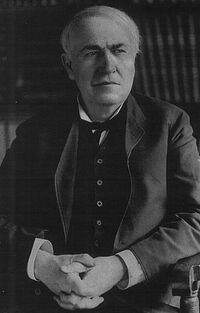
Thomas Alva Edison
The invention of the electric telegraph showed that commercial and practical use could be made of electrical phenomena. By the end of the 19th century electrical engineering became a distinct profession, separate from the physicist or inventor. The late 19th and early 20th century produced such giants of electrical engineering as Nikola Tesla, inventor of the polyphase induction motor; Samuel Morse, inventor of the telegraph; Antonio Meucci, an inventor of the telephone; Thomas Edison inventor of the phonograph; George Westinghouse, inventor of the electric locomotive; Charles Steinmetz, theoretician of alternating current; Alexander Graham Bell, another inventor of the telephone and founder of a successful telephone business.
The rapid advance of electrical technology in the latter 19th and early 20th centuries led to commercial rivalries, such as the so-called War of the Currents) between Edison's direct-current system and Westinghouse's alternating-current method. Often, concurrent research in widely scattered locations lead to multiple claims to the invention of a device or system.
Electric charge[]
- Main article: Electric charge
Electric charge is a property of certain subatomic particles (e.g., electrons and protons) which interacts with electromagnetic fields and causes attractive and repulsive forces between them. Electric charge gives rise to one of the four fundamental forces of nature, and is a conserved property of matter that can be quantified. In this sense, the phrase "quantity of electricity" is used interchangeably with the phrases "charge of electricity" and "quantity of charge." There are two types of charge: we call one kind of charge positive and the other negative. Through experimentation, we find that like-charged objects repel and opposite-charged objects attract one another. The magnitude of the force of attraction or repulsion is given by Coulomb's law.
The most common experience with electric charge in everyday life is that of static cling - when two particular types of materials are rubbed together, they tend to stick together, at least for a while. This phenomenon occurs because of the exchange of charges between the two materials — one becomes positively charged while the other becomes negatively charged, and because of their opposite signs there is a force of attraction between them. Another common experience with electric charge is that of walking on carpet and then touching a doorknob, where one experiences a shock. Walking on carpet causes the body to acquire a net charge, which then escapes from the body to the doorknob.
Electric field[]
- Main article: Electric field
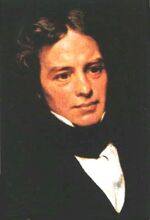
Michael Faraday
The concept of electric field was introduced by Michael Faraday. The electrical field force acts between two charges, in the same way that the gravitational field force acts between two masses. However, electric field is a little bit different. Gravitational force depends on the masses of two bodies, whereas electric force depends on the electric charges of two bodies. While gravity can only pull two masses together, the electric force can be an attractive or repulsive force. The criteria for the direction of the forces between two charged bodies are generally proposed as follows:
- Both charges are of same sign (e.g. both charges are positive), in which case there will be a repulsive force between the two.
- The charges are opposite, in which case there will be an attractive force between the two bodies.
- The magnitude of the force varies inversely with the square of the distance between the two bodies, and is also directly proportional to the product of the unsigned magnitudes of the two charges.
Electric potential[]
- Main article: Electric potential
The electric potential difference between two points is defined as the work done per unit charge (against electrical forces) in moving a positive point charge slowly between two points. If one of the points is taken to be a reference point with zero potential, then the electric potential at any point can be defined in terms of the work done per unit charge in moving a positive point charge from that reference point to the point at which the potential is to be determined. For isolated charges, the reference point is usually taken to be infinity. The potential is measured in volts. (1 volt = 1 joule/coulomb) The electric potential is analogous to temperature: there is a different temperature at every point in space, and the temperature gradients indicate the direction of heat flows. Similarly, there is an electric potential at every point in space, and its gradient in the electric field indicates where charges move.
Electric current[]
- Main article: Current (electricity)
An electric current is a flow of electric charge, and its intensity is measured in amperes. Examples of electric currents include metallic conduction, where electrons flow through a conductor such as a metal wire, and electrolysis, where ions (charged atoms) flow through liquids. The particles themselves often move quite slowly, while the electric field that drives them propagates at close to the speed of light. See electrical conduction for more information.
Devices that use charge flow principles in materials are called electronic devices.
A direct current (DC) is a unidirectional flow, while an alternating current (AC) reverses direction repeatedly. The time average of an alternating current is zero, but its energy capability (RMS value) is not zero.
Ohm's Law is an important relationship describing the behaviour of electric currents, relating them to voltage.
For historical reasons, electric current is said to flow from the most positive part of a circuit to the most negative part. The electric current thus defined is called conventional current. It is now known that, depending on the conditions, an electric current can consist of a flow of charged particles in either direction, or even in both directions at once. The positive-to-negative convention is widely used to simplify this situation. If another definition is used - for example, "electron current" - it should be explicitly stated.
Electrical energy[]
- Main article: Electrical energy
Electrical energy is energy stored in an electric field or transported by an electric current. Energy is defined as the ability to do work, and electrical energy is simply one of the many types of energy. Examples of electrical energy include:
- the energy that is constantly stored in the Earth's atmosphere, and is partly released during a thunderstorm in the form of lightning
- the energy that is stored in the coils of an electrical generator in a power station, and is then transmitted by wires to the consumer; the consumer then pays for each unit of energy he receives
- the energy that is stored in a capacitor, and can be released to drive a current through an electrical circuit
Electric power[]
- Main article: Electric power
Electric power is the rate at which electrical energy is produced or consumed, and is measured in watts (symbol: W).
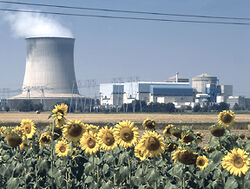
A nuclear power station.
A fossil-fuel or nuclear power station converts heat to electrical energy, and the faster the station burns fuel, assuming constant efficiency of conversion, the higher its power output. The output of a power station is usually specified in megawatts (millions of watts). The electrical energy is then sent over transmission lines to reach the consumers.
Each consumer uses appliances that convert the electrical energy to other forms of energy, such as heat (in electric arc furnaces and electric heaters), light (in light bulbs and fluorescent lamps), or motion, i.e. kinetic energy (in electric motors). Like the power station, each appliance is also rated in watts, depending on the rate at which it converts electrical energy into another form. The power station must produce electrical energy at the same rate as all the connected appliances consume it.
In electrical engineering, the concepts of apparent power and reactive power are also used. Apparent power is the product of RMS voltage and RMS current, and is measured in volt-amperes (VA). Reactive power is measured in volt-amperes-reactive (VAR).
SI electricity units[]
See also[]
- Electromagnetism
- Electrical engineering
- Electrical phenomena
- Electrostatics
Devices[]
- Battery
- Conductor
- Insulator
Engineering[]
- Green electricity
- Electrical wiring
Safety[]
- Electric shock
- High-voltage hazards
Electrical phenomena in nature[]
- Matter: — since atoms and molecules are held together by electric forces.
- Lightning: electrical discharges in the atmosphere.
- The Earth's magnetic field — created by electric currents circulating in the planet's core.
- Sometimes due to solar flares, a phenomenon known as a power surge can be created.
- Piezoelectricity: the ability of certain crystals to generate a voltage in response to applied mechanical stress.
- Triboelectricity: electric charge taken on by contact or friction between two different materials.
- Bioelectromagnetism: electrical phenomena within living organisms.
- Bioelectricity — Many animals are sensitive to electric fields, some (e.g., sharks) more than others (e.g., people). Most also generate their own electric fields.
- Gymnotiformes, such as the electric eel, deliberately generate strong fields to detect or stun their prey.
- Neurons in the nervous system transmit information by electrical impulses known as action potentials.
- Bioelectricity — Many animals are sensitive to electric fields, some (e.g., sharks) more than others (e.g., people). Most also generate their own electric fields.
External links[]
- What is electricity?
- Merriam-Webster: Electricity
- Tyndall: Faraday as Discovery: Identity of Electricities
- US Energy Department Statistics
- How to save on your electricity bills
- Electricity around the world
- A Comprehensive Collection of Franklin’s Electrical Works: The Electrical Writings of Benjamin Franklin, Created and Collected by Robert A. Morse (2004)
- Understanding Electricity and some Electronics in 10 minutes(Steve Rose, Maui)
- Electricity Misconceptions
ar:كهرباء bg:Електричество be:Электрычнасць bn:বিদ্যুত্ br:Tredan ca:Electricitat cs:Elektřina da:Elektricitet de:Elektrizität et:Elekter es:Electricidad eo:Elektro fa:الکتریسیته fr:Électricité gl:Electricidade ko:전기 io:Elektro id:Listrik he:חשמל kw:Tredan ku:Elektrîk lt:Elektra li:Elektriciteit nl:Elektriciteit no:Elektrisitet pt:Electricidade ru:Электричество simple:Electricity sl:Elektrika fi:Sähkö sv:Elektricitet zh:電
| This page uses Creative Commons Licensed content from Wikipedia (view authors). |